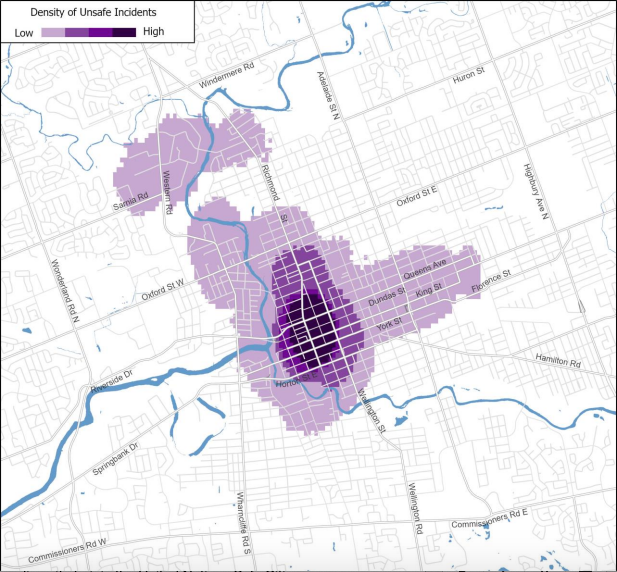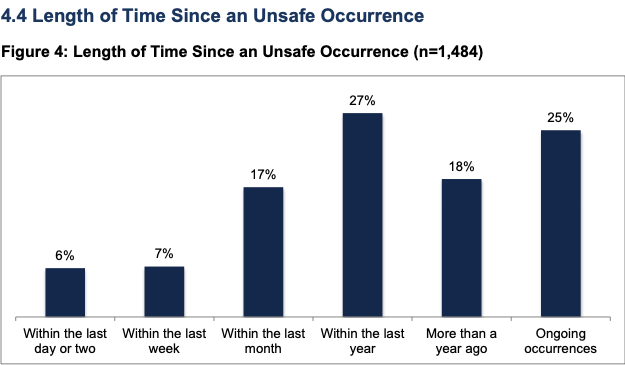Results of the Safe Cities London Scoping Study are shedding light on where women feel unsafe in the City of London and the forms of harassment or assault they experienced.

Safe Cities and Safe Public Spaces is a worldwide United Nations Women initiative that draws attention to the issue of violence against women and girls in public spaces.
This report provides a summary of the results from the Safe Cities London scoping study that took place from July 1 to Dec. 31, 2018, which includes data from the 1,825 pins on the participative mapping tool and focus groups.
The most common themes from respondents in the report were about incidents of sexual violence included non-physical sexual harassment, physical sexual harassment or aggression, and being followed, restrained, or restricted in a sexual manner.

The mapping data showed that those who participated felt most unsafe in the centre of the city along Richmond Street in downtown and then spread out from there, with 86 per cent of residents listing areas as unsafe compared to 14 per cent who felt safe.
“If we had not seen these areas highlighted we would have been concerned by the methodology we chose because we know from the national data these should have emerged,” said Dr. Annalise Trudell, manager of education, training and research at Anova.
“If we want to create a world without sexual violence and spaces without sexual violence there are certain folks that have very little to do without because it’s not happening within their space and others that can.”
Anova is a London-based organization that provides safe places, shelter, support, counselling, and resources for abused women, their children.
Trudell said bars, London Transit, and Western University are all places that can have an active impact, adding that London Transit and Western are actively working to combat the issue.

Get daily National news
Fanshawe College does not show up on the mapping tool, which Trudell said does not mean there is no sexual violence happening there, they did have issues getting the survey out to Fanshawe students.
- Veterans Affairs demands repayment of some benefits; process shocks veterans’ advocates
- Air Transat to begin cancelling flights Monday. What you need to know
- Will U.S. restart stalled trade talks with Canada? ‘We’ll see,’ says Trump
- Air Transat pilots gear up for strike as union issues 72-hour notice
The report collected data from testimonies of those who identified women and girls anonymously on their experiences living in London through focus groups and an interactive map allowing them to pin where they felt safe or unsafe in the city.
Focus groups targeted groups that have a higher rate of sexual violence in women and girls, including newcomers, Indigenous, LGTPQ+, and those with disabilities.
In September 2017 the Safe Cities initiative was unanimously endorsement by London City Council and London became the third Canadian city to join the United Nations Safe Cities initiative. Safe Cities London Advisory Committee is co-chaired by Anova and the City of London and is comprised of 18 different organizations or groups within London.
“Walking downtown, I often need to pass a collection of men who holler at women walking alone. They yell vulgar comments, but also make gestures, noises, and comments of displeasure if you walk confidently past. They appear upset that you ignore them,” one respondent said.

The report also showed that 25 per cent said feeling unsafe was an ongoing occurrence with 27 per cent saying it happens within the last year and 6 per cent saying it was in the last day or two.
In total, for 621 of the reported incidents, respondents described the perceived gender of the perpetrator with 97 per cent identified as male.
The report outlines the most common places where people reported incidents of violence with the most common one being in transit travelling from one place to another either on public transit or walking to and from somewhere.
“I was followed off the bus by a man. I was aware and tried to stop in an area to force the guy to ‘go where he was going,’ but he stopped as well, ” one respondent said.
Parks and green spaces were another key area women reported being harassed and physically assaulted.
“I was raped by the river because nobody hears or sees anything,” a respondent said.
Other areas of concern identified were residential areas, shopping centres, downtown, nightlife entertainment spaces like bars and clubs, and campuses and school as well as workplaces.
The findings in this report will be used to inform the development of strategies to prevent and respond to violence against women and girls in public spaces through the development and implementation of a Safe Cities Action Plan.
“It takes a community and we are trying to take a community-led approach to change that happens,” Rosanna Wilcox, director of service, innovation and performance with the City of London.
Trudell said moving forward by standard training is one of the main priorities they will be taking in the coming months, working to include those that work at bars in the community.
Wilcox said to create a community-wide understanding of sexual violence it is key to include men as allies, addressing consent culture, and helping bystanders understood how to help.
At this time there is not final impact associated with the report.
The Safe Cities London Scoping study will be presented to councillors at next week’s Community and Protective Services Committee meeting on March 2.
If you or someone you know requires support or information relating to violence, please call Anova’s 24/7 crisis and support line at 519-642-3000.












Comments